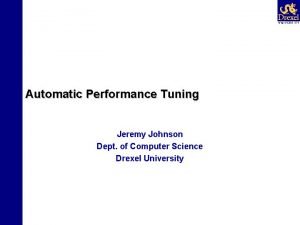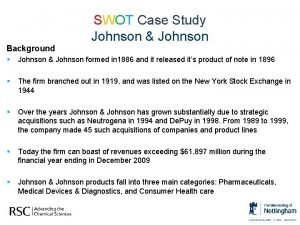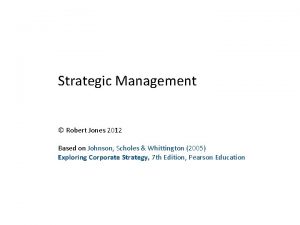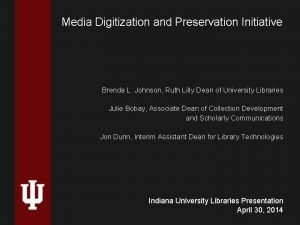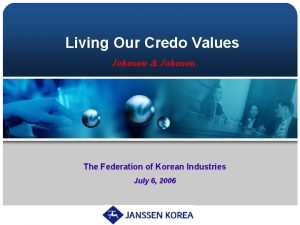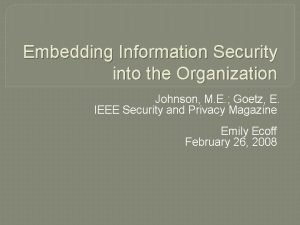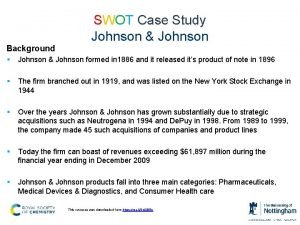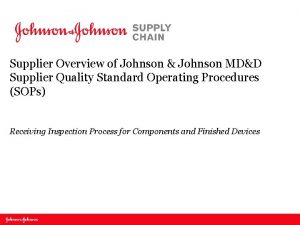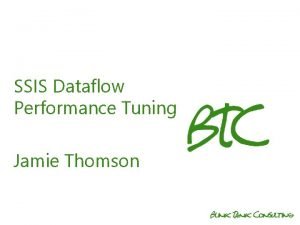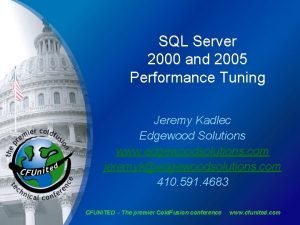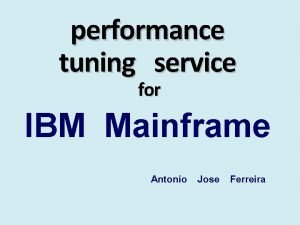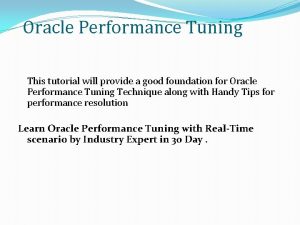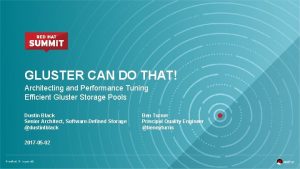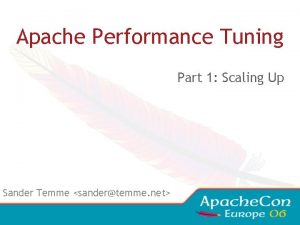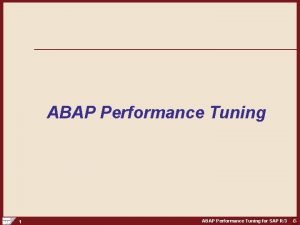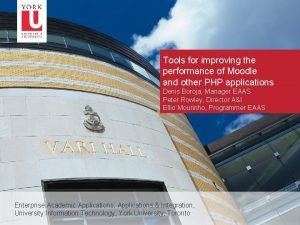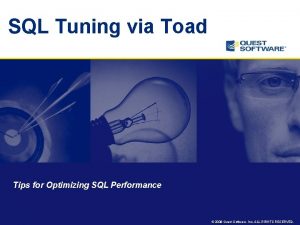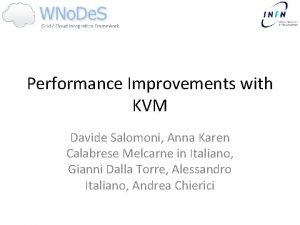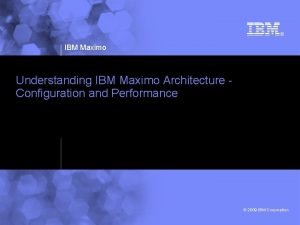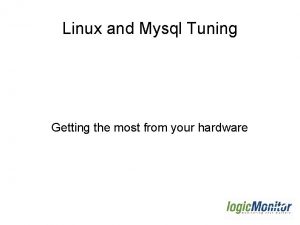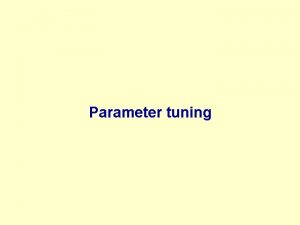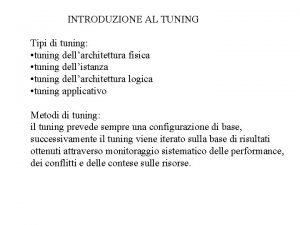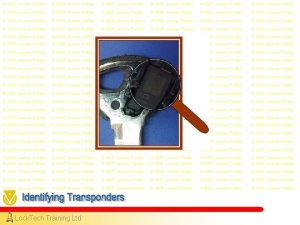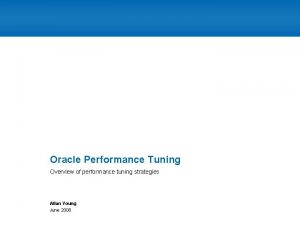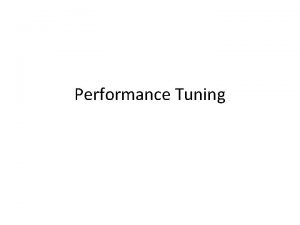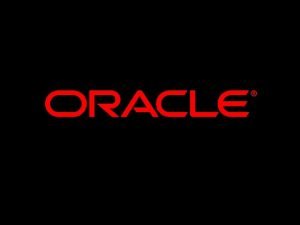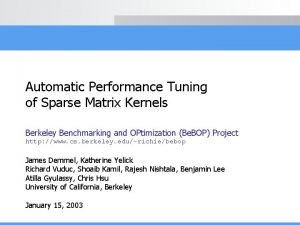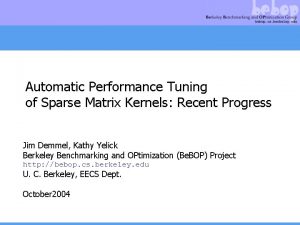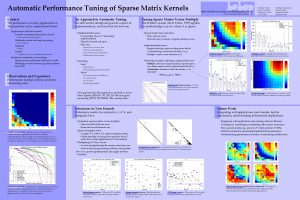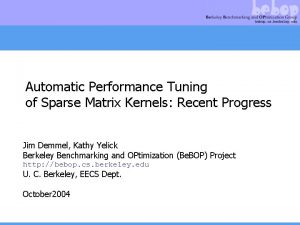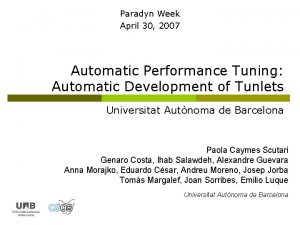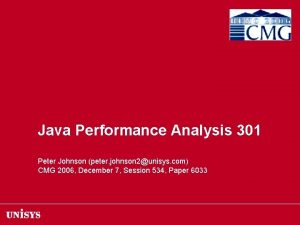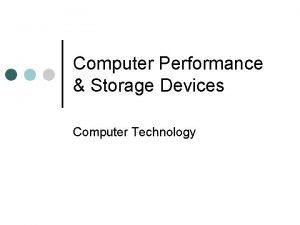Automatic Performance Tuning Jeremy Johnson Dept of Computer

























- Slides: 25

Automatic Performance Tuning Jeremy Johnson Dept. of Computer Science Drexel University

Outline • Scientific Computation Kernels – Matrix Multiplication – Fast Fourier Transform (FFT) – Integer Multiplication • Automated Performance Tuning (IEEE Proc. Vol. 93, No. 2, Feb. 2005) – – ATLAS FFTW SPIRAL GMP

Matrix Multiplication and the FFT

Basic Linear Algebra Subprograms (BLAS) • • • Level 1 – vector-vector, O(n) data, O(n) operations Level 2 – matrix-vector, O(n 2) data, O(n 2) operations Level 3 – matrix-matrix, O(n 2) data, O(n 3) operations = data reuse = locality! • LAPACK built on top of BLAS (level 3) – Blocking (for the memory hierarchy) is the single most important optimization for linear algebra algorithms • GEMM – General Matrix Multiplication – SUBROUTINE DGEMM (TRANSA, TRANSB, M, N, K, ALPHA, A, LDA, B, LDB, BETA, C, LDC ) – C : = alpha*op( A )*op( B ) + beta*C, – where op(X) = X or X’

DGEMM … * * 50 60 70 80 90 … Form C : = alpha*A*B + beta*C. DO 90, J = 1, N IF( BETA. EQ. ZERO )THEN DO 50, I = 1, M C( I, J ) = ZERO CONTINUE ELSE IF( BETA. NE. ONE )THEN DO 60, I = 1, M C( I, J ) = BETA*C( I, J ) CONTINUE END IF DO 80, L = 1, K IF( B( L, J ). NE. ZERO )THEN TEMP = ALPHA*B( L, J ) DO 70, I = 1, M C( I, J ) = C( I, J ) + TEMP*A( I, L ) CONTINUE END IF CONTINUE

Matrix Multiplication Performance

Matrix Multiplication Performance

Numeric Recipes • Numeric Recipes in C – The Art of Scientific Computing, 2 nd Ed. – William H. Press, Saul A. Teukolsky, William T. Vetterling, Brian P. Flannery, Cambridge University Press, 1992. • • “This book is unique, we think, in offering, for each topic considered, a certain amount of general discussion, a certain amount of analytical mathematics, a certain amount of discussion of algorithmics, and (most important) actual implementations of these ideas in the form of working computer routines. 1. Preliminarys 2. Solutions of Linear Algebraic Equations … 12. Fast Fourier Transform 19. Partial Differential Equations 20. Less Numerical Algorithms

four 1

four 1 (cont)

FFT Performance

Atlas Architecture and Search Parameters • • NB – L 1 data cache tile size NCNB – L 1 data cache tile size for non-copying version MU, NU – Register tile size KU – Unroll factor for k’ loop LS – Latency for computation scheduling FMA – 1 if fused multiply-add available, 0 otherwise FF, IF, NF – Scheduling of loads Yotov et al. , Is Search Really Necessary to Generate High-Performance BLAS? , Proc. IEEE, Vol. 93, No. 2, Feb. 2005

ATLAS Code Generation • Optimization for locality – Cache tiling, Register tiling

ATLAS Code Generation • Register Tiling NU – MU + NU + MU×NU ≤ NR • • Loop unrolling Scalar replacement Add/mul interleaving Loop skewing K B • Ci’’j’’ = Ci’’j’’ + Ai’’k’’*Bk’’j’’ NB MU NB K A C mul 1 mul 2 … mul. Ls add 1 mul. Ls+1 add 2 … mul. Mu×Nu add. Mu×Nu-Ls+2 … add. Mu×Nu

ATLAS Search • Estimate Machine Parameters (C 1, NR, FMA, LS) – Used to bound search • Orthogonal Line Search (fix all parameters except one and search for the optimal value of this parameter) – Search order • NB • MU, NU • KU • LS • FF, IF, NF • NCNB • Cleanup codes

Using FFTW

FFTW Infrastructure • Use dynamic programming to find an efficient way to combine code sequences. • Combine code sequences using divide and conquer structure in FFT • Codelets (optimized code sequences for small FFTs) • Plan encodes divide and conquer strategy and stores “twiddle factors” • Executor computes FFT of given data using algorithm described by plan. Right Recursive 15 3 12 4 8 3 5

SPIRAL system n a i tic a m he controls algorithm generation Formula Generator t a M goes for a coffee fast algorithm as SPL formula t r e p x E Compilermer SPL m a r g o r P controls implementation options C/Fortran/SIMD code platform-adapted implementation Search Engine specifies runtime on given platform comes back (or an espresso for small transforms) SPIRAL DSP transform user

DSP Algorithms: Example 4 -point DFT Cooley/Tukey FFT (size 4): Fourier transform Diagonal matrix (twiddles) Kronecker product Identity Permutation

Cooley-Tukey Factorization Fourier transform Diagonal matrix (twiddles) Kronecker product Identity Permutation § algorithms reduce arithmetic cost O(N^2) O(Nlog(N)) § product of structured sparse matrices § mathematical notation exhibits structure § introduces degrees of freedom (different breakdown strategies) which can be optimized

Algorithms = Ruletrees = Formulas R 1 R 6 R 3 R 6 R 1 R 4 R 3 R 6 R 4

Generated DFT Vector Code: Pentium 4, SSE (Pseudo) gflop/s hand-tuned vendor assembly code n DFT 2 n single precision, Pentium 4, 2. 53 GHz, using Intel C compiler 6. 0 speedups (to C code) up to factor of 3. 1

Best DFT Trees, size 2 Pentium 4 float scalar 8 2 2 1 2 5 2 2 2 3 3 3 9 2 3 5 7 2 5 2 4 4 2 2 2 10 5 5 3 2 6 2 4 10 1 2 5 10 4 2 2 2 10 7 2 6 2 2 6 10 2 10 SIMD 3 4 4 2 8 2 2 2 4 8 5 2 2 10 6 2 10 4 4 2 4 Athlon. XP float 10 8 2 6 2 2 Pentium III float 10 2 C vect = 1024 Pentium 4 double 10 2 10 3 2 3 trees platform/datatype dependent 5 3 2 3

Slowdown factor w. r. t. best Crosstiming of best trees on Pentium 4 n DFT 2 n single precision, runtime of best found of other platforms software adaptation is necessary

GMP Integer Multiplication • Polyalgorithm – – Classical O(n 2) algorithm Karatsuba Toom-Cook Schönhage-Strassen (FFT) 3 E-05 0. 007 0. 0069 FFT 5888 2. 5 E-05 0. 0068 Toom 3 117 2 E-05 0. 0067 • Algorithm Thresholds 1. 5 E-05 0. 0066 – Thresholds determine when one algorithm switches to the 1 E-05 next – Tune-up program empirically 5 E-06 sets threshold parameters for given platform 0 0. 0065 0. 0064 0 50 Karatsuba 34 0. 0063 100 0. 0062 5781 150 200 . . . 5831 5881 5931 5981 *Default tuning @ AMD Athlon X 2 2. 8 GHz / 32 -bit Linux
 Quién soy como me llamó
Quién soy como me llamó Jeremy johnson drexel
Jeremy johnson drexel Johnson and johnson background
Johnson and johnson background Johnson and johnson bcg matrix
Johnson and johnson bcg matrix Laurie johnson brad johnson
Laurie johnson brad johnson Credo values
Credo values Johnson and johnson organizational structure
Johnson and johnson organizational structure Johnson and johnson botnet infections
Johnson and johnson botnet infections Johnson and johnson swot
Johnson and johnson swot Jjeds employee directory
Jjeds employee directory Johnson and johnson three c's of classroom management
Johnson and johnson three c's of classroom management Johnson and johnson md&d
Johnson and johnson md&d Buffertempstoragepath
Buffertempstoragepath Sql 2005 performance
Sql 2005 performance Mainframe tuning
Mainframe tuning Oracle sql tuning tutorial
Oracle sql tuning tutorial Glusterfs performance tuning
Glusterfs performance tuning Xampp performance tuning
Xampp performance tuning Performance tuning in abap
Performance tuning in abap Yorku moodle app
Yorku moodle app Toad sql tuning
Toad sql tuning Ssas performance tuning
Ssas performance tuning Sshfs performance tuning
Sshfs performance tuning Maximo architecture
Maximo architecture Apache performance tuning
Apache performance tuning Mysql huge pages
Mysql huge pages

